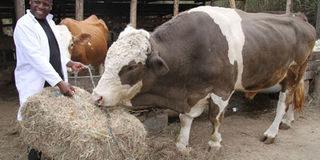I saw a gap in cow breeds, now I’m making my millions

Workers attend to Gerald Besseling Fleckvieh cows breed at his farm in Karen on July 9, 2014.Photo/JEFF ANGOTE (NAIROBI)
What you need to know:
- I sell crossbreed semen for between Sh4,000 and Sh6,000, while the pure breed for more than Sh10,000.
- To date, I have sold more than 45,000 Fleckvieh crossbreeds semen to farmers through my firm Fleckvieh Genetics East Africa. Fleckvieh crossbreeds are more popular than the pure breed because the latter is expensive.
While growing up in Holland in 1960s, I used to hear stories of how beautiful Kenya was from my parents and relatives.
Those of us who had not visited Kenya had mental images of its lovely beaches and breathtaking sceneries.
In my young mind, Kenya was heavenly. As I grew up, I made up my mind that I had to visit Kenya, as a tourist. But over the years, this changed to relocation, but I had to find a solid reason. I was keeping livestock and growing crops in Holland. I saw coming to Kenya as an extension of my farming.
My answer came one day in 2002 while researching online about the Fleckvieh cow. In spite of being one of the most popular breeds across the world — that has been around since 1890, I was surprised that it was non-existent in Kenya, a country whose flowers the Dutch are obsessed with.
Fleckvieh cows are among the dual-purpose breeds of the world. If a Fleckvieh cow is lactating, then it should eat 25kg of feed a day. This is half what a Friesian eats, and it maintains a flat milking curve for 305 days.
I thought how much of a difference the breed would create for farmers if introduced in Kenya. I called my wife and told her, “Honey, I now have a reason to go to Kenya.” A few months later that year, I arrived in the country and immediately started making arrangements to ship the first Fleckvieh cow to Kenya.
Getting an importation licence was hard because not many people, including at the Ministry of Agriculture, knew what the breed was about.
For seven years, I struggled to get an importation licence, but as I did this, I saw another opportunity in the transport sector. I set up a transport logistics company known as Amicabre Tours.
This is what kept my dream alive. In June 2009, I brought into the country the first Fleckvieh cow, just in time for the inaugural Brookside Livestock Breeders Show.
The heifer arrived from South Africa to much fanfare at the airport.
In the run up to the day, I had put up a billboard near the City Stadium with photos of Fleckvieh cows saying, “We are coming to Kenya,” and even paid for adverts in newspapers. I spent $20,000 (Sh1.7 million) to buy and import the cow from South Africa.
But this did not bother me because I knew I had something that would change the country in 10 years. I exhibited the animal at the show and there was interest. But there were challenges.
While people showed interest, this did not translate into sales. A majority of farmers knew that the best cow breed was Friesian. They could not believe that a cow with a huge body could produce a lot of milk and still be a good meat producer.
When Fleckvieh became a hard sale, I imported another cow. This time, a crossbreed of a Friesian and a Fleckvieh. The two cows proceeded to win awards from one agricultural show to another, making farmers to start accepting them.
About five years after the first Fleckvieh cow landed in the country, farmers are now embracing it.
To date, I have sold more than 45,000 Fleckvieh crossbreeds semen to farmers through my firm Fleckvieh Genetics East Africa. Fleckvieh crossbreeds are more popular than the pure breed because the latter is expensive.
Crossbreed semen
I sell crossbreed semen for between Sh4,000 and Sh6,000, while the pure breed for more than Sh10,000.
I recently made deals with two county governments that want semen straws in an effort to change the fortunes of farmers. Bomet County government has agreed to get its farmers subsidised 3,000 straws of Fleckvieh crossbreed semen. Siaya County has also ordered 500 straws.
I am a firm believer that for Kenya to move from third world status to first world, the country does not need to industrialise heavily. It can depend on agriculture entirely and still become a developed country. Countries like Brazil have done it.
However, there are some things I feel that if farmers change, their fortunes too would better. For instance, those who feed their cows with hay commit a mistake by cutting long grass and using it to make hay.
You should cut the grass immediately it rains, and it must have not grown more than half a foot. Young grass has more nutrients than mature ones. In Holland, the biggest export is cheese. And one of the reasons we have succeeded is because farmers have formed cooperatives.




